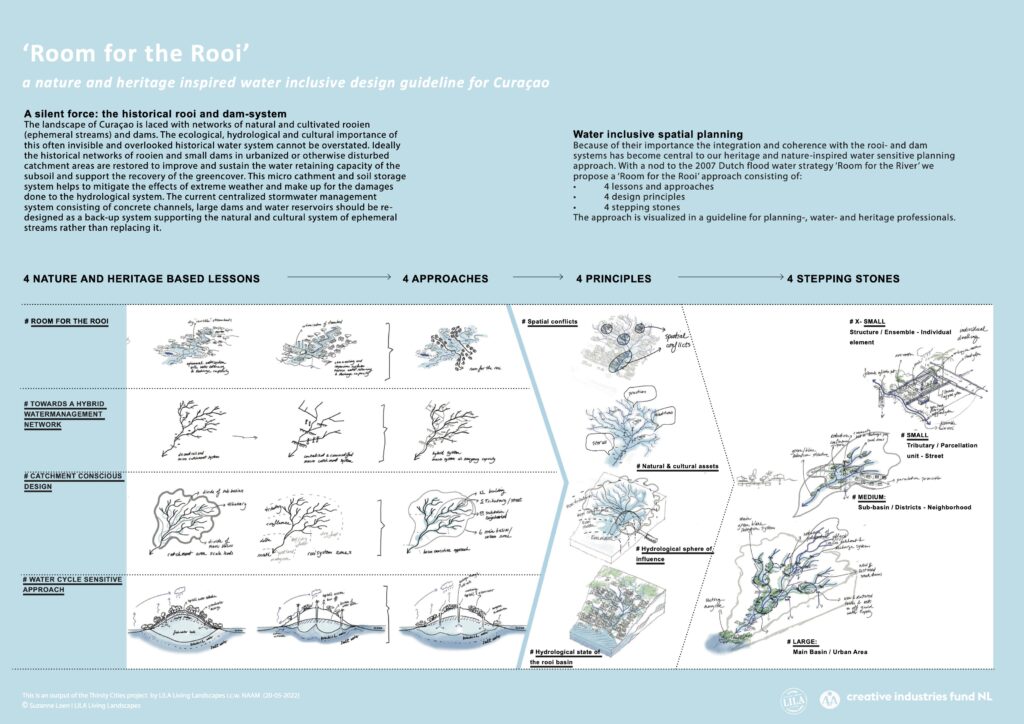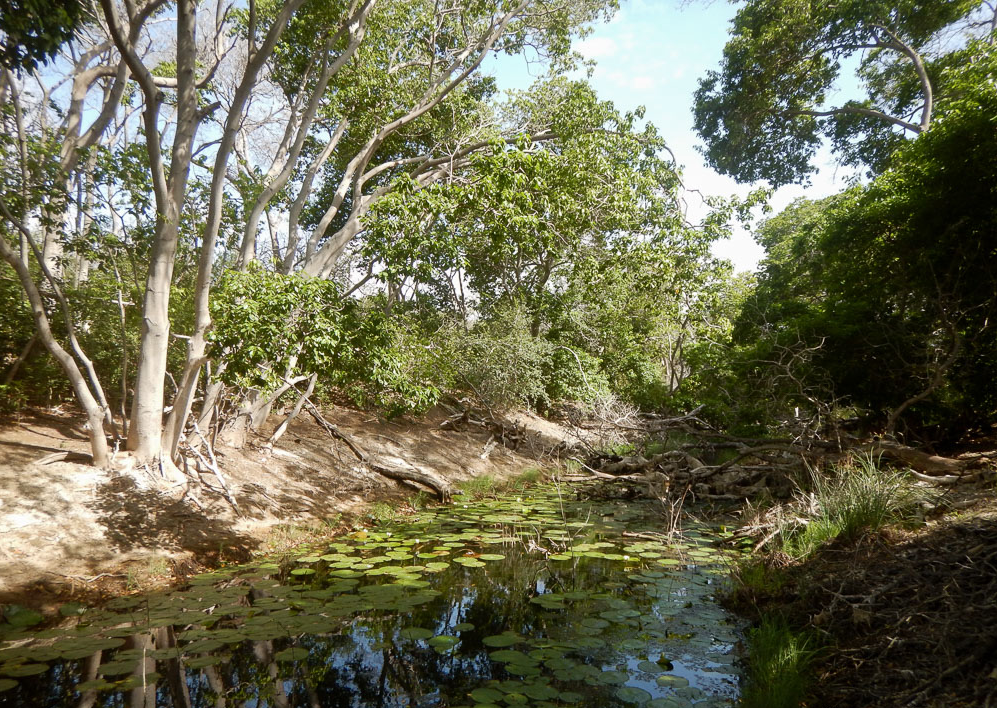With a nod to the Dutch flood water strategy ‘Room for the River’ we propose a ‘Room for the Rooi’ strategy. A nature and heritage inspired water inclusive spatial planning strategy for Curaçao. Consisting of 3 lessons from the past to built resilience for the future.

Nature and Heritage Inspired Water Inclusive Design Guidelines for Curaçao. ©LILA Living Landscapes
Caribbean Small Island Developing States (SIDS) like Curaçao are extremely vulnerable to the effects of the climate crises. These regions are subject to increased flood risk and long periods of extreme drought due to ever more erratic weather patterns. Historic and present day water challenges on Curaçao and ways of dealing with them in the past and present can help us develop solutions for the future to adapt to and mitigate the effects of climate change in the future. In the Water Biography and Timeline you can read more about the historical development of fresh water management systems in Curaçao.

Historical development land- and waterscape of Curaçao. ©LILA Living Landscapes
Room for the Rooi / Ruimte voor de Rooi
The historical networks of gullies (ephemeral streams) a.k.a. rooien and dams were already cultivated in pre-Columbian times. Rooi-systems are often neglected or disturbed during urbanisation and land use changes. This development has resulted in significant reduced water retaining capacity and increased flood risk during heavy rain. Because of their importance the integration and coherence with the rooi-systems has become central to our heritage and nature based water sensitive planning strategy.

Room for the Rooi. ©LILA Living Landscapes
#1. Water cycle sensitive approach
The historical clearing in colonial times of the island forest cover and mangrove belt and over-abstraction of groundwater resources has impacted the water cycle significantly. Climate change has intensified the paradox of long periods of extreme droughts and flash floods. Strategic restoration of mangrove and green cover could help reduce salt intrusion and increase the water retaining capacity in the subsoil.

Water cycle sensitive approach. ©LILA Living Landscapes
# 2. Catchment conscious design
Curaçao is laced with a delicate network of ephemeral streams and dams (locally a.k.a. rooien, gullies, guts or ghuts). While invisible during dry periods these stream beds together support large catchment areas and green structures with significant water retaining capacity. From upstream, to the rooi delta downstream zoning plans and spatial developments should be in coherence and designed with their impact on the rooi basin, sub-basin, green cover and water retaining capacity in mind. A protective zone or bandwidth projected on the rooi structures could be helpfull.

Catchment Conscious design. Image ©LILA Living Landscapes
# 3. Towards a hybrid water network
The historical informal network of ephemeral streams has been largely replaced with a formalised system of concrete gutters. Where possible restore the natural courses and structures of rooien and dams while maintaining the formal network of gutters for stormwater capacity

Towards a hybrid centralised and off grid water system. Image ©LILA Living Landscapes
NL Samenvatting:
Juist op kleine Caribische eilanden als Curaçao verergert de klimaatcrisis de al bestaande paradox van lange perioden van droogte en onregelmatige perioden van extreme regenval en overstromingen in het regen- en orkanenseizoen. Een watersysteem van rooien- (geulen van vluchtige waterstromen) en dammen, onderdeel van het historische natuur- en cultuurlandschap van Curaçao kan bijdragen aan de veerkracht van de water- en groensystemen van het eiland, mitigatie en klimaatadaptatie.
# Room for the Rooi / Ruimte voor de Rooi
Het watersysteem van rooien en dammen, onderdeel van het natuur- en cultuurlandschap van Curaçao, werd al door de inheemse gemeenschappen gecultiveerd ten behoeve van zoetwater management. Gedurende de kolonisatie verdween, met deze gemeenschappen, veel van hun kennis en kunde. Deze vaak (onzichtbare) waterstructuren hebben een significante waterbergende capaciteit en vormen een belangrijke ruggengraat voor groenstructuren en biodiversiteit. Bij veranderend landgebruik en toenemende verstedelijking raakt dit watersysteem vaak in de verdrukking waardoor de waterbergende capaciteit en de groenstructuren worden aangetast. De natuur- en erfgoedinclusieve benadering Ruimte voor de Rooi (met een knipoog naar het programma Ruimte voor de Rivier) pleit voor een duurzame ruimtelijke ontwikkeling waarin het rooi- en dammensysteem sturend is. De water sensitive urban design guidelines ondersteunen een natuurinclusieve stedelijke en ruimtelijke ontwikkeling.
©Suzanne Loen / LILA Living Landscapes
Published 24 februari 2022
This project is executed in collaboration with Claudia Kraan from NAAM (National Archeological Anthropological Memory Management Curaçao) and financially supported by Creative Industries Fund NL.
